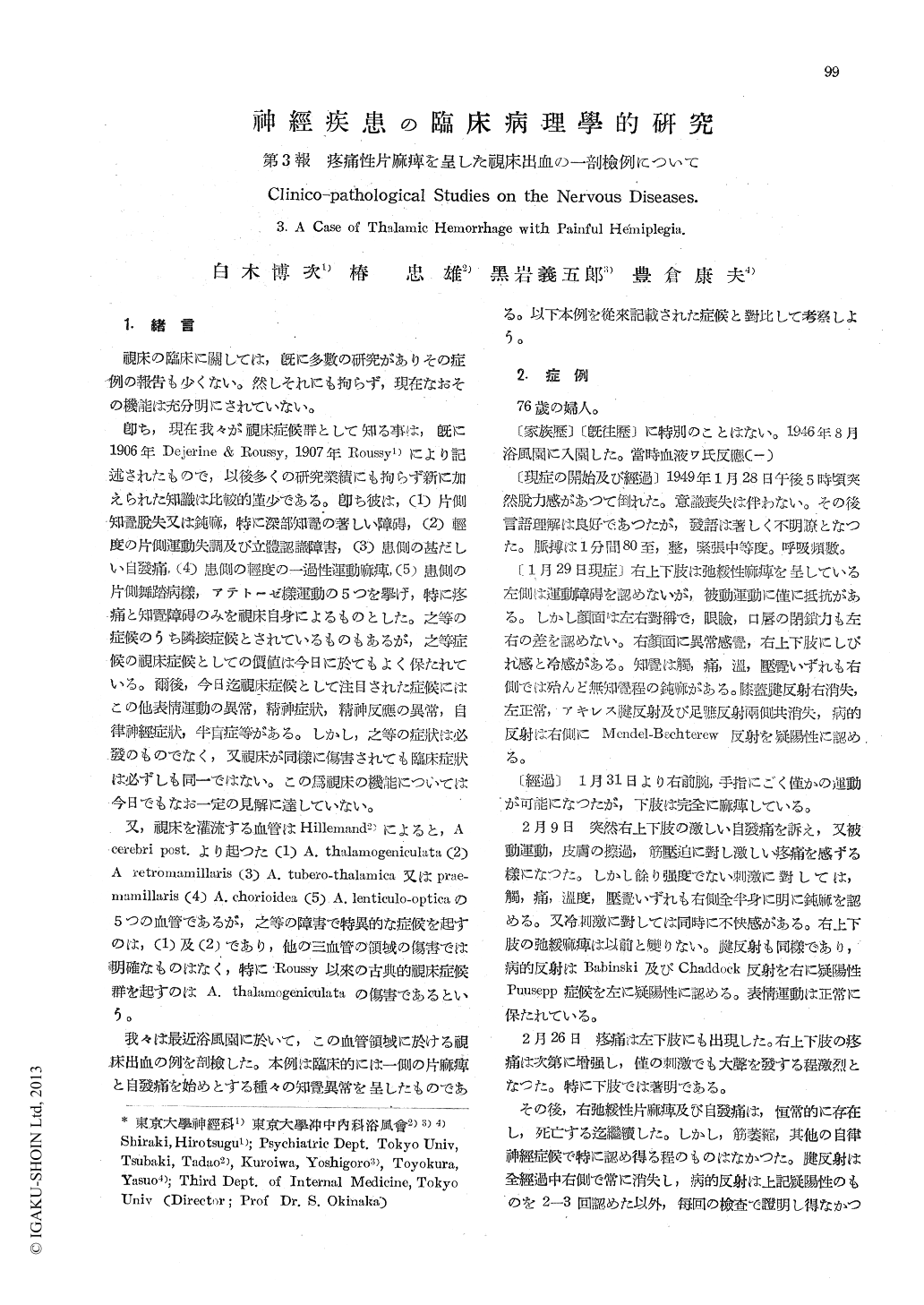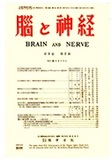Japanese
English
- 有料閲覧
- Abstract 文献概要
- 1ページ目 Look Inside
1.緒言
視床の臨床に關しては,既に多數の研究がありその症例の報告も少くない。然しそれにも拘らず,現在なおその機能は充分明にされていない。
即ち,現在我々が視床症候群として知る事は,既に1906年Dejerine & Boussy,1907年Roussy1)により記述されたもので,以後多くの研究業績にも拘らず新に加えられた知識は比較的僅少である。既ち彼は,(1)片側知覺脱失又は鈍麻,特に深部知覺の著しい障碍,(2)輕度の片側運動失調及び立體認識障害,(3)患側の甚だしい自發痛,(4)患側の輕度の一過性運動麻痺,(5)患側の片側舞踏病樣,アテトーゼ樣運動の5つを擧げ,特に疼痛と知覺障碍のみを視床自身によるものとした。之等の症候のうち隣接症候とされているものもあるが,之等症候の視床症候としての價値は今日に於てもよく保たれている。爾後,今日迄視床症候として注目された症候にはこの他表情運動の異常,精神症状,精神反應の異常,自律神經症状,半盲症等がある。しかし,之等の症状は必發のものでなく,又視床が同樣に傷害されても臨床症状は必ずしも同一ではない。この爲視床の機能ついては今日でもなお一定の見解に達していない。
Case. K. T., 76 year old female.
On Jane 28, 1949, she had an apoplectic insult without loss of consciousness and thereby develop-ed right sided flaccid hemiplegia. The facial nerve was intact. Striking hypesthesia on the affected side was noted. Since Jan. 31, 1949, she had been able to move slightly her forearm and fingers of the affected side. On Feb. 9, she suddenly com-plained of severe spontaneous pain on the affected extremities. The pain was provoked by passive movement of the extremities, by rubbing the skin and by pressing the muscles. The marked hypes-thesia was still proved on the affected side by weak stimulation. Reaction of the affected ex-tremities to cold was accompanied by uncomforta-ble sensation. This flaccid hemiplegia and sponta-neous pain had remained until she died on March 28. On Feb. 26, she told that she felt similar pain on her left leg. The right knee-jerk disa-ppeared while the left remained normal. the ancle jerk and plantar refiex were absent on both sides. Pathologicar refiexes were generally not observed except Babinski's sign, Chaddok's sign and Mendel-Bechterew's sign on the right side and Puusepp's sign on the left side were noted for a short period of time. Facial expresion was normal. There were no marked contracture, muscle atrophy or other autonosmic symptoms.
Autopsy findings.
Hemorrhagic softening was found on almost all area of pulvinar thalami and the adjacent tail of caudate nucleus of the left side. This lesion was traced rostrally to the lateral nucleus, where it became gradually smaller and smaller in its dorsal portion and ended in the frontal sections through the anterior of the mamillary body. The ante-rior nucleus and internal nucleus of the thalamus were intact. The internal capsule was slightly aff-ected, lccalizing chiefly in the posterior part of its posterior limb. No degeneration of the pyra-midal tract was found at pons and medulla oblon-gata.
Comment The sensory disturbance observed in our patient is similar to what has been known as the thalamic syndrome described by Roussy and many other authors. But it attracts our attention that our patient showed almost complete hemiplegia for 2 months. We are considering that the lesion of the thlamus, rather than that of the pyramidal tract may have a close relationship to this hemi-plegia, because, firstly, the lesion was chiefly lo-calized in the thalamus, secondly, the destruction of the iternal capsule was very slight, and thirdly, no degeneration was found in the pyramidal tract

Copyright © 1951, Igaku-Shoin Ltd. All rights reserved.


